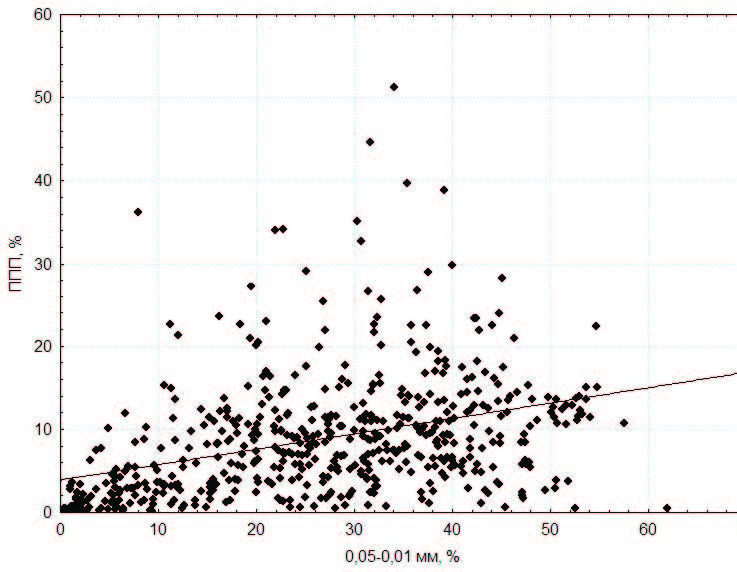Structural relationship of granulometric composition, content of organic matter and heavy metals in sediments
Keywords:
metals, bottom sediments, pelytic fraction, loss of ignition, lakesAbstract
The extensive factual material shows that the granulometric composition of sediments, their organic matrix and the content of various forms of metals in them are closely interconnected and form a structure, the basis of which determines the ratio of silt and pelytic fractions. Moreover, it is on particles with a size corresponding to the interface between these fractions (0.05-0.01 mm) that the bulk of the exchangeable, mobile forms of elements, as well as organic matter, presented in the form of weakly mineralized fine detritus, are concentrated. In turn, the distribution of metals in sediments is regulated by the forms of their compounds with an organic and inorganic matrix. The first group of metals (Pb, Cd, Zn, Cu) is represented by elements with high biological accumulation coefficients in aquatic organisms, which determines their entry into sediments with detritus. The second group consists of scattered metals entering aquatic ecosystems with an allochthonous surface runoff consisting of highly dispersed particles of suspensions (Cr, Ni, Co), as well as typomorphic elements such as iron and manganese.
References
Budnikov G.K. Tyazhelye metally v ekologicheskom monitoringe vodnyh sistem [Heavy metals in environmental monitoring of water systems] // Sorosovskij obrazovatel'nyj zhurnal. 1988. No 5. P. 23‒29.
Bulgakov D.S. Agroekologicheskaya ocenka pahotnyh pochv [Agroecological assessment of arable soils]. M.: RAAS, 2002. 250 p.
Valiev V.S., Ivanov D.V., Ziganshin I.I., Shamaev D.E., Malanin V.V., Marasov A.A. Analiz raspredeleniya form metallov v donnyh otlozheniyah ozer prirodnyh i urbanizirovannyh territorij Respubliki Tatarstan [Analysis of the distribution of metal forms in the bottom sediments of lakes in natural and urban areas of the Republic of Tatarstan] // Trudy Karel'skogo nauchnogo centra RAN. Ser. Limnologiya [Proceedings of the Karelian Scientific Center of the Russian Academy of Sciences. Series Limnology.]. 2016. No 9. P. 57-67.
Venicianov E.V Fiziko-himicheskie osnovy modelirovaniya migracii i transformacii tyazhelyh metallov v prirodnyh vodah [Physicochemical fundamentals of modeling the migration and transformation of heavy metals in natural waters] / Ed. A.M. Chernyaev. Ekaterinburg: Izd-vo RosNIIVH, 2002. 235 p.
Demina L.L. Formy migracii tyazhelyh metallov v okeane [Forms of migration of heavy metals in the ocean]. M.: Nauka, 1982. 117 p.
Dobrovol'skij V.V. Rol' guminovyh kislot v formirovanii migracionnyh massopotokov tyazhelyh metallov [The role of humic acids in the formation of migratory mass flows of heavy metals] // Pochvovedenie [Soil Science]. 2004. №1. P. 32‒39
Zubenko I.V., Linnik P.N. Frakcionnoe raspredelenie tyazhelyh metallov v donnyh otlozheniyah vodohranilishch Dnepra [Fractional distribution of heavy metals in the bottom sediments of the Dnieper reservoirs] // Gidrobiologicheskij zhurnal [Hydrobiological Journal]. 1997. Vol. 33, No 3. P. 101‒102.
Kulikov A.S., Sadchikov A.P., Maksimov V.N. Struktura detrita i associirovannye s nim bakterii v dvuh raznyh po trofnosti vodoemah [The structure of detritus and bacteria associated with it in two reservoirs of different trophicity] // Biologicheskie nauki [Biological Sciences]/ 1990. №8. С. 85‒93.
Manihin V.I., Nikanorov A.M. Rastvorennye i podvizhnye formy tyazhelyh metallov v donnyh otlozheniyah presnovodnyh ekosistem [Dissolved and mobile forms of heavy metals in bottom sediments of freshwater ecosystems]. SPb.: Gidrometeoizdat, 2001. Water quality Series.. Iss. 5.182 p.
Sadchikov A.P. Strukturnye pokazateli bakterij i detrita v presnyh vodoemah (metodicheskie aspekty) [Structural indicators of bacteria and detritus in fresh water (methodological aspects)] // Materialy po flore i faune Respubliki Bashkortostan / Sbornik statej. Ufa: RIC BashGU, 2016. Iss. XII. P. 37‒42.
Skobeeva T.N. Producirovanie organicheskogo veshchestva v vodoemah i ego destrukciya fito- i bakterioplanktonom [Organic matter production in water bodies and its destruction by phyto- and bacterioplankton]: Diss. … kand. biol. nauk. М., 1999. 133 p.
Grotti M., Soggia F., Ianni C., Magi E., Udisti R. Bioavailability of trace elements in surface sediments from Kongsfjorden, Svalbard // Marine pollution bulletin. 2013. 15. 77. P. 367‒374.
Heiri O., Lotter A.F., Lemcke G. Loss on ignition as a method for estimating organic and carbonate content in sediments: reproducibility and comparability of results // Journal of paleolimnology. 2001. No 25. Р. 101‒110.
Martin J.M., Meybeck M. Elemental mass-balance of material carried by major world rivers // Marine chemistry. 1977. Vol. 7. P. 173–206.
Milliman J.D., Mead R.H. World-wide delivery of river sediment to the ocean // Journal of geology. 1983. Vol. 91. P. 1–21.
Wolter K. Bacterial in corporation of organic substances released by natural phytoplankton population // Marine Ecology ‒ Progress Series. 1982. Vol. 17, No 3. Р. 287‒295.





